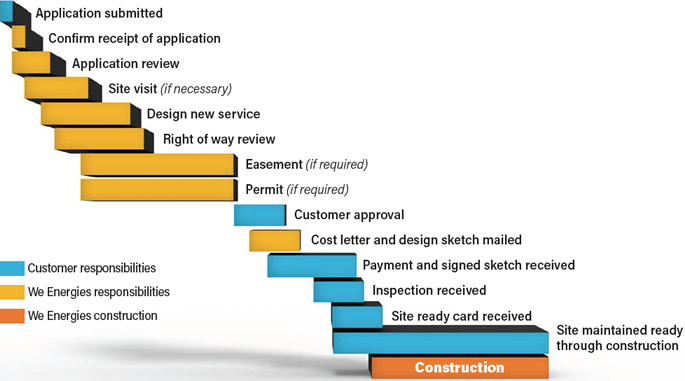
Step 1 – Application
Submit a New Service Residential Application with plat of survey/site plan (at least 90 days prior to date natural gas
and/or electric service is required).
Involve your builder and contractors when completing the Electric and/or Gas Requirements Section of the application.
This data ensures correct service size. Include a copy of your elevation plan illustrating door and window placement.
Step 2 – Receive confirmation
We will call you to confirm that we've received your new service application. If we need additional information to process
your request, we will let you know.
Step 3 – Site visit
Once all required information is received and verified, we schedule a site visit.
Step 4 – Design
A design is created using data collected during the site visit. When the design is complete, we contact you to discuss costs,
credits and extension agreements (if applicable). A design sketch and cost letter is mailed to you.
Depending on the job, all applicable requirements must be completed before we schedule installation. Note: Permits can take
8 weeks or more.
- Right of way. If your job requires obtaining easements, we must determine a path that is acceptable
to all parties (including third parties where required). A signed authorization approving the easement is required.
- Environmental. Wetlands, waterways, threatened or endangered species, cultural or historical resources
as well as hazardous spills or materials will delay the project, as permits would need to be requested and approved.
- Permits. Municipal, county and state permit requirements as well as environmental concerns (mentioned
above) can impact the installation timeline.
Step 5 – Scheduling requirements
We require the following before scheduling construction:
- Payment (if applicable)
- Signed approval of design sketch
- Signed ready for service card(s)
- Inspection (electric only) – an inspection form must be received from the municipal inspector confirming that the customer-owned equipment is wired correctly.
Your project can be delayed if these requirements are not met or site is not ready upon arrival to perform work.
Construction delay examples
The construction timeline begins at this step, which means installation will be approximately three weeks from this point.
Larger jobs could be longer.
Step 6 – Scheduling
When all scheduling requirements are received, we schedule your job.
Step 7 – Outage coordination (electric only)
Sometimes installation work requires an outage for other customers served from the same distribution system. When this occurs, we attempt to
coordinate the outage to minimize impact. Some outages require considerable coordination.
Step 8 – Energizing service
We install a meter and energize service when work is completed. Larger jobs require us also to perform a separate inspection. The energized
date for larger jobs may trail construction completion date by a few days.
Step 9 – Lawn and pavement repair
To allow for natural settling, repair work typically begins a minimum of three weeks after the work is completed. Exceptions to this are:
- Inclement weather.
- Other work activities in the same area, such as road widening, road resurfacing, municipal sewer or water work, etc., that make it
necessary to coordinate efforts and delay repair. Let us know if you are aware of any planned municipal work.
- Trenching construction, which requires a longer time to settle. Repair work is planned about six weeks from the trench-backfilling
date.
- When weather conditions (typically winter) prohibit repair activities for the season, we notify you that restoration will be completed
in the spring. As soon as we can resume repair work, we provide you with an expected completion date.
Road weight restrictions, weather conditions and repair work backlog from the previous year are factors in repairing surfaces.